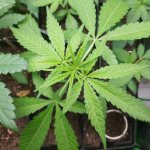Autos ain't what they used to be, there's quite a few new ones that are pretty much the auto version of their photo lineage. If I were going for sativas that's the route I would go.
The fact the highland does well with temp swings doesn't really surprise me. Anything highland is going to be dealing with pretty large swings from day and night temps, and an overall lower temp than lowland tropical strains.
The fact the highland does well with temp swings doesn't really surprise me. Anything highland is going to be dealing with pretty large swings from day and night temps, and an overall lower temp than lowland tropical strains.




